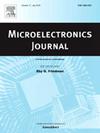A calibration scheme for SAR ADCs based on capacitor weight optimization using an improved simulated annealing algorithm
IF 1.9
3区 工程技术
Q3 ENGINEERING, ELECTRICAL & ELECTRONIC
引用次数: 0
Abstract
This paper proposes a foreground calibration method, which applies simulated annealing (SA) algorithm to the calibration of successive approximation register analog-to-digital converters (SAR ADCs). The capacitor weights are updated according to the performance metrics of the output codes, without necessitating any signal injection or modifying the analog structure of the SAR ADC. The methods of iterative and parallel solving, as well as variable searching step size are introduced into the SA calibration for adequate search. In addition, a multi-objective optimization strategy based on lexicographic optimization is used to take into account the performance of both signal-to-noise and distortion ratio (SNDR) and spurious-free dynamic range (SFDR). The estimated capacitor weights are applied in the digital domain to calibrate the SAR ADC output codes. The effectiveness of this calibration method is verified by simulating a 12-bit SAR ADC model with 2-bit redundancy and calibrating a 16-bit, 500 kS/s SAR ADC with 4-bit redundancy fabricated in 180 nm technology. The simulation results show the significant improvements in both SNDR and SFDR, along with a notable enhancement in integral nonlinearity (INL). 512 sinusoidal signal samples are collected on testing platform to extract the capacitor weights that can further contribute to the calculation of the output codes. The experiment results show that the SNDR and SFDR are improved by 20.04 dB and 20.19 dB, respectively, while the INL are enhanced by nearly 16 LSB.
求助全文
约1分钟内获得全文
求助全文
来源期刊

Microelectronics Journal
工程技术-工程:电子与电气
CiteScore
4.00
自引率
27.30%
发文量
222
审稿时长
43 days
期刊介绍:
Published since 1969, the Microelectronics Journal is an international forum for the dissemination of research and applications of microelectronic systems, circuits, and emerging technologies. Papers published in the Microelectronics Journal have undergone peer review to ensure originality, relevance, and timeliness. The journal thus provides a worldwide, regular, and comprehensive update on microelectronic circuits and systems.
The Microelectronics Journal invites papers describing significant research and applications in all of the areas listed below. Comprehensive review/survey papers covering recent developments will also be considered. The Microelectronics Journal covers circuits and systems. This topic includes but is not limited to: Analog, digital, mixed, and RF circuits and related design methodologies; Logic, architectural, and system level synthesis; Testing, design for testability, built-in self-test; Area, power, and thermal analysis and design; Mixed-domain simulation and design; Embedded systems; Non-von Neumann computing and related technologies and circuits; Design and test of high complexity systems integration; SoC, NoC, SIP, and NIP design and test; 3-D integration design and analysis; Emerging device technologies and circuits, such as FinFETs, SETs, spintronics, SFQ, MTJ, etc.
Application aspects such as signal and image processing including circuits for cryptography, sensors, and actuators including sensor networks, reliability and quality issues, and economic models are also welcome.
 求助内容:
求助内容: 应助结果提醒方式:
应助结果提醒方式:


